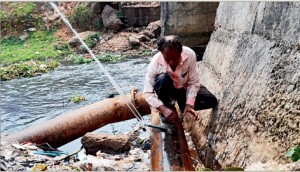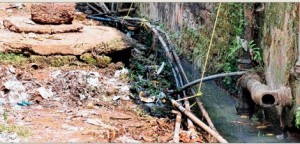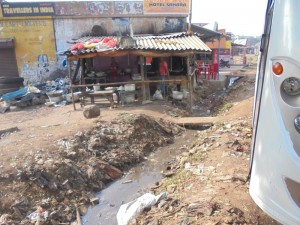 By Sandeep Banerjee: Bhubaneswar is today listed as one of the fastest developing capital cities in the country. But despite all its outward glitz and development of concrete structures, actually much is still amiss as far as the intrinsic development of the city is concerned. A big question mark hangs over the basic health and sanitation scenario in the city, the overt manifestation of which lies in the number of people getting afflicted by diseases like jaundice and swine flu. Contrary to claims of impeccable civic condition by the concerned authorities, actually unhygienic conditions prevail in many parts of the capital which in turn has become the root cause for the spread of diseases and constantly poses an open health threat to the citizens of the city.
By Sandeep Banerjee: Bhubaneswar is today listed as one of the fastest developing capital cities in the country. But despite all its outward glitz and development of concrete structures, actually much is still amiss as far as the intrinsic development of the city is concerned. A big question mark hangs over the basic health and sanitation scenario in the city, the overt manifestation of which lies in the number of people getting afflicted by diseases like jaundice and swine flu. Contrary to claims of impeccable civic condition by the concerned authorities, actually unhygienic conditions prevail in many parts of the capital which in turn has become the root cause for the spread of diseases and constantly poses an open health threat to the citizens of the city.
After Sambalpur and Cuttack where it has taken epidemic proportions, jaundice has reared its ugly head in the capital city. In a case of cluster attack, as many as 40 policemen residing in the reserve police barracks have suffered from the disease in the last two months. Because of overcrowding, the hygiene and sanitation inside the barracks was compromised. The jawans also have low hygiene sense. The barracks near Acharya Vihar Square house 1,000 jawans though the space is meant for only 350. It is close to a natural drain. The low-lying surroundings invariably get flooded during rain.
 One of the most dangerous threats is that of sewage water leaking into the supply water pipelines. The slow pace of replacing the leaking water pipelines by the Public Health Engineering department has worsened the jaundice scenario in the city. Pipelines carrying drinking water are running close to drains and often dirty water is seeping into these supply lines.
One of the most dangerous threats is that of sewage water leaking into the supply water pipelines. The slow pace of replacing the leaking water pipelines by the Public Health Engineering department has worsened the jaundice scenario in the city. Pipelines carrying drinking water are running close to drains and often dirty water is seeping into these supply lines.
The problem is not new but has been building up over the years. Even from central parts of the city there have been complaints of the same. To cite an example, The Odisha News Insight followed up complaints of citizens of Ashok Nagar in the very heart of the capital. Regular skin and stomach ailments have appeared in the area and the citizens openly blame the seepage of sewer water into the supply water as the cause for it. They have already moved the PHED with their complaint.
“Yes we are getting complaints from the residents of some areas and as a result the water supply has been disconnected and we have been providing them water through tankers. However, it is not yet established how sewage water has been leaking into piped water. Investigation is on to detect the leakage.” said a senior officer in PH division-I while talking to ONI.
 The delay in execution of the integrated sewerage system in the city has put a question mark on residents’ safety with jaundice spreading its tentacles. Sewerage integration separates the sewerage water from drain water. While drains carry rainwater, sewers carry waste-water from houses. But, while the 440-km long old sewerage system barely covers half the city, the new system has failed to make much progress since its launch in 2008. As jaundice is a water-borne disease, contamination of drain water has every chance of infecting pipe water.
The delay in execution of the integrated sewerage system in the city has put a question mark on residents’ safety with jaundice spreading its tentacles. Sewerage integration separates the sewerage water from drain water. While drains carry rainwater, sewers carry waste-water from houses. But, while the 440-km long old sewerage system barely covers half the city, the new system has failed to make much progress since its launch in 2008. As jaundice is a water-borne disease, contamination of drain water has every chance of infecting pipe water.
According to the new project, to be executed under the Odisha Water Supply and Sewerage Board, the integrated system has to add 412 km new sewer lines in areas that have none at all. Integration of old and new sewerage systems through six sewerage districts is significant. Each of these will have an independent sewerage treatment plant to treat the effluents. But no one knows what the present status of the sewerage treatment plants is.
The Board’s Project Engineer, B.C. Tripathy said that the problem lies in monetary issues. “So far, we have laid 145-km long sewerage lines in the city. The work has been a little slow as the contractor was expecting more. Once the government permits the hike, the work will progress smoothly.” he said. However, he added that even if some of the pipelines had been laid across the city, no progress has been made regarding the construction of the independent sewerage treatment plants. “Though tendering process has started, it is now entangled in legal battles causing a stalemate,” he revealed to ONI.
The authorities and Departments concerned are not to be blamed alone. The public apathy towards hygiene and civic sense is also an issue of concern. There are open eateries aside sewerage water outlets and gutters. People litter and pile garbage without paying any heed and the BMC garbage vats are often not used. The household connections taken from the supply line of the Public Health Engineering Department have also come under the scanner. “We have come across many cases. But, civic authorities should take action against the violators as we do not have execution power or enforcement mechanism,” said the Superintending Engineer of PHED, Chitta Ranjan Jena. “It is imperative to detect the illegal connections from the public water supply line and if pipes are found to be leaking or passing near drains, notices must be issued to the households. Similarly, illegal release of waste water into roadside drains must be stopped”, he added.
 It is pertinent to note that most of the points, where leakage in the pipelines has been detected so far, are in service connections to households and several of them have been found to be unauthorized connections. Many of these pipelines are buried under silt in the drains have also added to the problem. Unless the Municipal Corporation removes the sludge from the drains, it is becoming difficult to replace the pipelines.
It is pertinent to note that most of the points, where leakage in the pipelines has been detected so far, are in service connections to households and several of them have been found to be unauthorized connections. Many of these pipelines are buried under silt in the drains have also added to the problem. Unless the Municipal Corporation removes the sludge from the drains, it is becoming difficult to replace the pipelines.
On level of Institutions, The Odisha State Pollution Control Board (OSPCB) has issued a show-cause notice to Omfed’s biggest plant at Chandrasekharpur in the capital for allegedly causing water pollution. Water used for processing milk should be treated in an Effluent Treatment Plant (ETP) before it is discharged. Though the Omfed plant is having an ETP to treat 200 kilo litre of water a day, it is not being used.
According to OSPCB, the plant is producing 2.5 lakh litre of milk and using 400 kilo litre of water a day. But the water, after milk processing, contains a lot of fats and other polluting chemicals. The OSPCB has also pointed out that stagnant untreated water on the plant premises may contaminate groundwater. For industrial waste water, the permissible limit of Biochemical Oxygen Demand (BOD) is 30 ml a litre of water. But, BOD was found to be three times higher in the Omfed plant discharged waste water.
